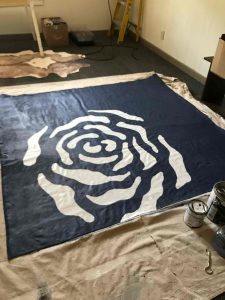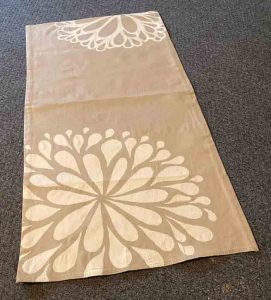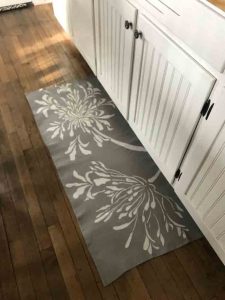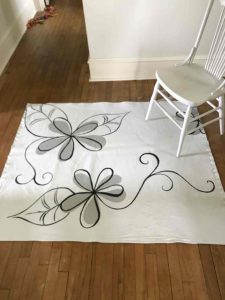Make a Canvas Washable Rug
Make a Canvas Washable Rug
Make a Canvas Washable Rug
Truthfully, I came up with this project to make a canvas washable rug because I was feeling creative. I wanted to have a rug that looked nice and covered the floors but I didn’t want to have to worry about spilling paint or food on it that couldn’t be washed. Even more than that, I was feeling artsy and wanted to create something artistic but not to hang on the wall. I needed to create something that was functional. This project completely satisfied that need! When I say “washable”, I do not necessarily mean you can put it in your washer. At least, I haven’t tried that yet.
Prepping to Make a Canvas Washable Rug
1. Find the best fabric and cut to desired size.
There are a couple of different approaches to this. Determine first of all where you’d like to use this rug. If it is an indoor rug and you’d like it to be flexible and lightweight, go for a lightweight canvas or a heavier cotton/polyester blend. Durability is often more important then you can get a heavier fabric. However, keep in mind that you will be putting multiple coats of paint on at least one side of the fabric. Paint both sides for an outdoor use, just remember, the rug will be heavier and less flexible. Determining the size you need can be complicated, so start smaller and think about the sizes of the rugs in your house. Try not to go too big for your first rug. Fabric or canvas sizes may be a limiting factor as well. Various sizes such as 4×12 or 5×8 may work well.
2. Finish the edges of the fabric with a nice wide hem so that the rug will stay flat and not curl up. If you need help with this, see the tutorial here.
3. Determine a space that will accommodate your rug for a few days to allow paint to dry. Lay out your rug fabric on top of a drop cloth. The project may take a few days, depending on the details of your design.
Painting Your Canvas
4. Apply the first coat of primer on the top side (where the design will be). For the photo shown (black rug with rose design), I painted one coat of primer and a coat of navy before I painted the white rose on the top. The back part of the photo, for the faux animal rug, I painted a white primer and then used multiple colors to show the animal fur effect. (Sorry I do not have better photos for the one in the back.)

5. After the first side is primed and painted, check the back to see if it looks like it needs priming as well. Depending on your fabric, the paint may show through. At this point, you may choose to prime/paint, or just wait to protect it with a polyurethane protectant. (See the supplies list below).
Design of Your Canvas Rug
6. Now, the fun part…deciding what your design will be. Use chalk to draw out where you will paint the desired design. Chalk is easy because it shows against the paint and is also easy to wash off. Once you paint your design on the rug, make sure to allow it to dry thoroughly.
7. Roll on the Polyurethane protectant. This will help to keep it somewhat water-resistant. If you paint both sides, it is especially durable. Allow each side to dry at least overnite.



This is a great project to do with kids! Anyone can help create a functional rug that cleans up easily! Paint both sides of cloth for durability and to make it somewhat water resistant. Paint only one side for flexibility. I have one rug for my kitchen and one for my greenhouse!
Supplies you will need:
4×12 or 5×8 works well or any light to medium weight material (keep in mind that if you paint both sides, it may increase stiffness if material is too heavy) cut to desired size
Latex primer (optional- you may opt to use several coats of paint…this depends on how much of the original fabric you would like to show through)
Latex paint for background and to paint designs
Paint rollers, at least one for paint and one for primer
Chalk– light color for marking on top of dark paint and dark color for marking on top of lighter color paint
This is a great project to do with kids! Anyone can help create a functional rug that cleans up easily! Paint both sides of cloth for durability and to make it somewhat water resistant. Paint only one side for flexibility.

